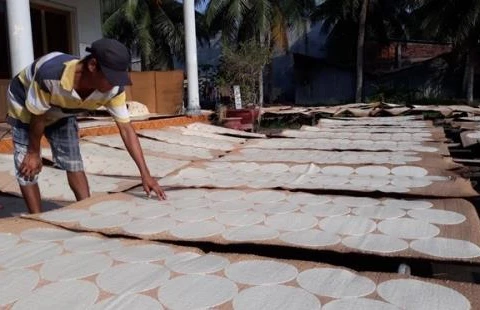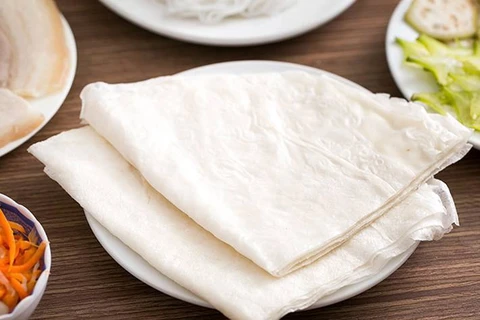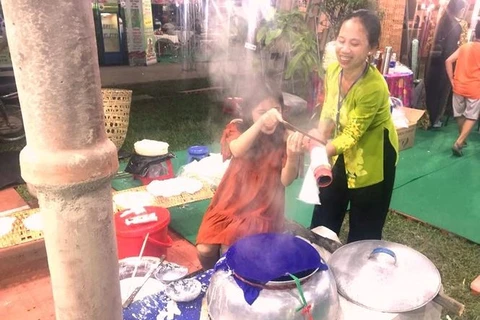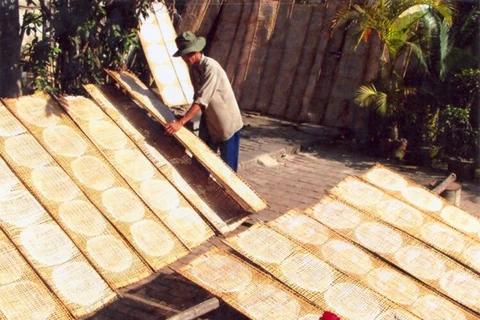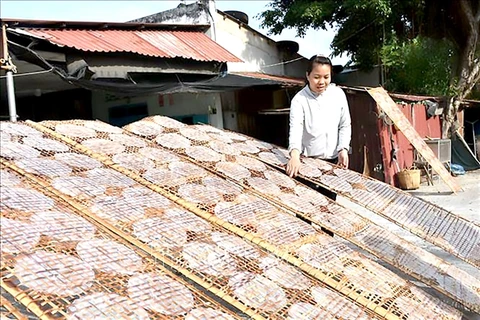
Photo: Representatives from Can Tho city People’s Committee hand over a decision recognising Thuan Hung rice paper making as a national intangible cultural heritage. (Photo: VNA)
Can Tho (VNA) – The over 200-year-old rice paper making in Thuan Hung ward, Thot Not district, in the Mekong Delta city of Can Tho, has been recognised as a national intangible cultural heritage.
Thuan Hung villagers have been making rice papers for more than 200 years with a total of 500 establishments.
On May 19, the municipal Department of Culture, Sports and Tourism coordinated with the People's Committee of Thot Not district to organise a ceremony to announce a decision dated March 16, 2023 recognising the craft as a national intangible cultural heritage.
This is the first traditional craft in Can Tho to receive this honour.
Thuan Hung rice paper makers are mostly living in two areas of Tan An and Tan Phu, with 68 households using traditional manual methods and three others using machines in making rice papers.
As Thuan Hung rice papers have gradually become popular in the market, more and more local households have engaged in the craft. Makers have their tips passed on from generation to generation.
There are many types of rice paper in Thuan Hung, each has its own flavour that cannot be found anywhere else.
The village households specialise in making different kinds of flavoured rice paper: plain, salted, sweetened, and coconut, all of which can be used to wrap spring rolls, dip in water, grill, or eat raw.
Plain rice paper is especially popular during Tet (Lunar New Year) holiday, as it is used as offerings to ancestors and as treats for guests.
Thuan Hung rice paper is delicious, has a fragrant rice flavour, and is not mushy.
Moreover, the rice paper making village in Thuan Hung has become a very famous tourist attraction.
Arriving at the village gate, visitors will feel the typical aroma of smoke and coconut powder. Especially, they can see racks of rice papers evenly dried.
Visiting the village, people can learn how to make rice paper in the way local Thuan Hung people do.
Rice paper makers usually use a dipper to measure the amount of rice flour for each paper.
After being milled, the rice flour liquid is poured onto the strainer on the pot.
Villagers said that tips to make delicious, thin, and not crushed rice paper are to make sure the fire is low and the papers are coated quickly. Rice flour liquid is steamed for about 15 seconds.
Taking it out requires rhythmic coordination between the maker and the taker. As the rice paper is very thin, wet, and prone to tear. Therefore, the person who takes it must be skillful and gentle with one hand holding the paper and the other spreading it on a rack.
The drying process depends a lot on weather conditions. It is necessary to pay attention to the process to ensure that dried rice papers will not be warped and torn.
On sunny days, it takes about 30 minutes to dry the rice papers. Exposed longer under the sun's heat, they will be easily broken.
The recognition of Thuan Hung rice paper making as a national intangible cultural heritage is an important basis for the locality to research, propose, and set measures to preserve and promote the craft, thereby promoting the Thuan Hung rice paper brand in the market.
Apart from the rice paper making village in Thuan Hung, Can Tho is also known for the Cai Rang floating market and “don ca tai tu” (traditional musical art form of the south), have been recognised as national intangible cultural heritage./.

